- Comfrey Cultivation: All You Need to Know
- Introduction
- Choosing a Comfrey Species
- Propagation
- Planting
- Care and Maintenance
- Harvesting
- Uses
- Potential Concerns
- Conclusion
- Benefits and Properties of Comfrey
- Comfrey as a Medicinal Herb
- Traditional Uses
- Active Compounds
- Safety and Precautions
- Conclusion
- Comfrey in Organic Gardening
- 1. Nutrient Accumulator:
- 2. Organic Fertilizer:
- 3. Pest Control:
- 4. Soil Improvement:
- 5. Compost Activator:
- Different Varieties of Comfrey
- How to Grow Comfrey
- 1. Select a suitable location:
- 2. Prepare the soil:
- 3. Start from seeds or divisions:
- 4. Plant or transplant:
- 5. Watering:
- 6. Mulching:
- 7. Fertilization:
- 8. Harvesting:
- 9. Maintenance:
- Harvesting and Using Comfrey
- Harvesting Comfrey
- Using Comfrey Leaves
- Using Comfrey Roots
- Comfrey in Permaculture: A Sustainable Solution
- Soil Improvement
- Natural Pest Control
- Medicinal Uses
- Conclusion
- Questions and Answers:
- What is comfrey?
- How can I cultivate comfrey in my garden?
- What are the properties of comfrey?
- Are there different species of comfrey?
- Can I use comfrey as a natural fertilizer?
- What precautions should I take when using comfrey?
- Videos: Free Fertilizer – How to Make Comfrey Tea
Welcome to the ultimate guide on comfrey, a fascinating and versatile plant with numerous cultivation techniques, beneficial properties, and diverse species. Comfrey, also known as Symphytum, has been used for centuries for its medicinal and horticultural purposes. Its deep taproot and large leaves make it a valuable addition to any garden or herbal remedy collection. Whether you are a seasoned gardener or a herbal enthusiast, this guide will provide you with all the information you need to get started with comfrey.
In this guide, you will discover the various species of comfrey, including Symphytum officinale, Symphytum x uplandicum, and Symphytum peregrinum. Each species has its own unique characteristics and growing requirements. You will learn how to choose the right species for your garden and how to propagate comfrey through seeds, cuttings, or division. Additionally, you will find tips on cultivating comfrey in different climates and soil types.
Comfrey is not only a beautiful addition to your garden but also a plant with many beneficial properties. Its leaves contain high levels of nutrients, making it an excellent addition to compost or as a green manure crop. Comfrey also has medicinal properties and has been used to treat various ailments such as bruises, wounds, and joint inflammation. You will discover how to harness the healing properties of comfrey through infusions, poultices, or salves.
So, whether you are interested in growing comfrey for its horticultural benefits, for its medicinal properties, or simply for the joy of having a beautiful plant in your garden, this ultimate guide will provide you with the knowledge and techniques to successfully cultivate and utilize comfrey in your own space.
Comfrey Cultivation: All You Need to Know
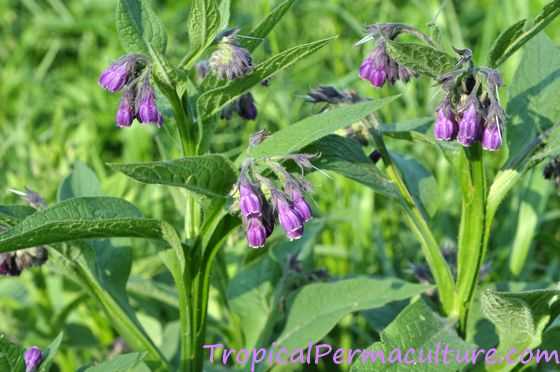
Introduction
Comfrey is a versatile herbaceous plant that is often cultivated for its many beneficial properties. It has been used for centuries in traditional medicine and is also valued for its ability to improve soil fertility. In this guide, we will explore everything you need to know about comfrey cultivation.
Choosing a Comfrey Species
There are several species of comfrey, but the two most commonly cultivated are Symphytum officinale and Symphytum × uplandicum. Make sure to choose a species that is well-suited to your climate and growing conditions.
Propagation
Comfrey can be propagated either by seeds or root divisions. While seeds can be sown directly into the garden, root divisions are a more reliable method as they ensure the plant retains its desired characteristics. To propagate by root division, carefully dig up the plant and separate the roots, ensuring each division has at least one bud.
Planting
Comfrey prefers full sun, but can tolerate some shade. It also thrives in well-drained soil with a pH level between 6.0 and 7.0. Plant the root divisions or seeds in the spring, spacing them at least 24 inches apart. Water thoroughly after planting and keep the soil consistently moist until the plants are established.
Care and Maintenance
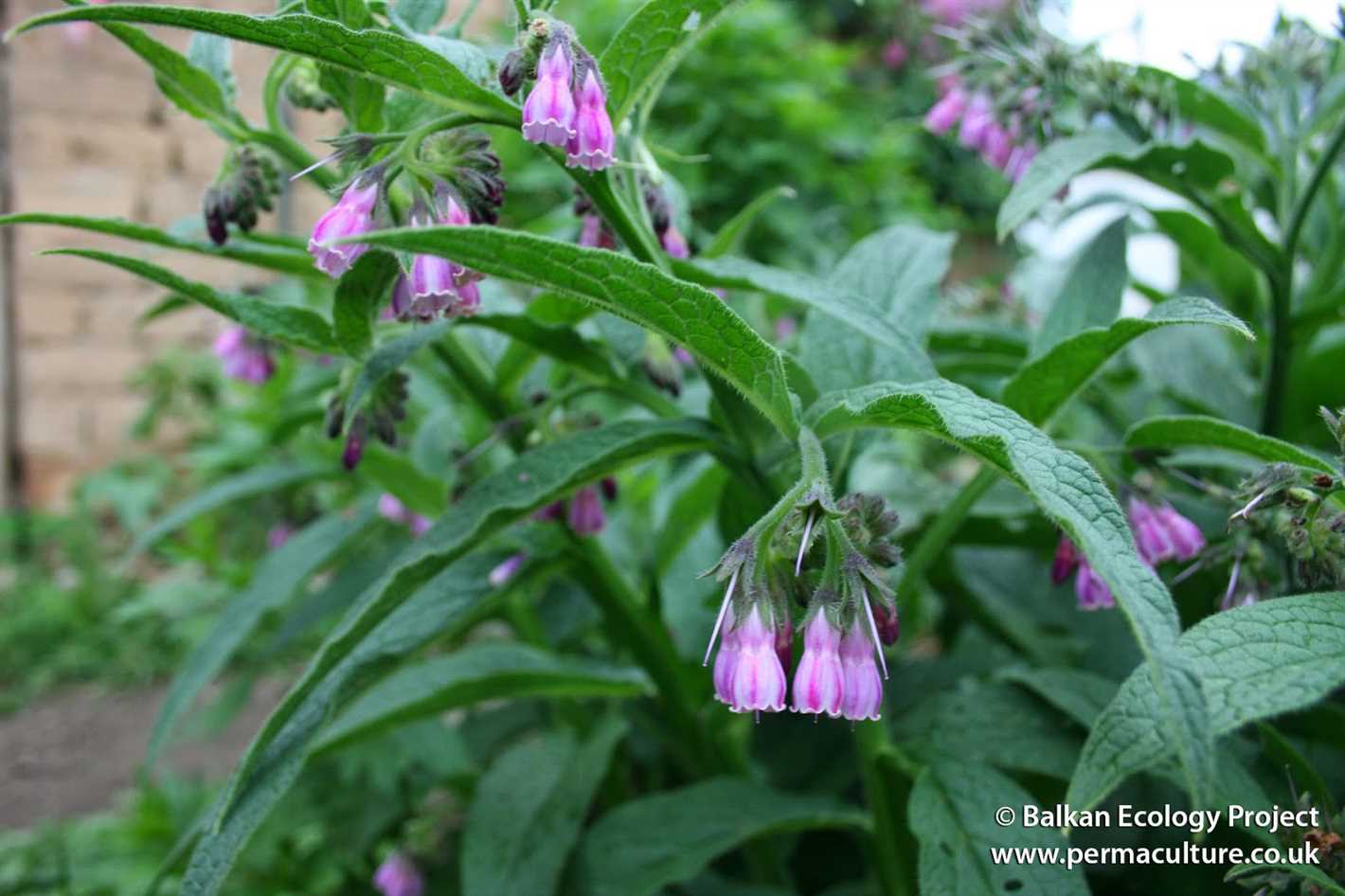
Comfrey requires minimal care once established. However, it is important to keep the plants well-watered, especially during dry periods. Mulching around the plants can help conserve moisture and suppress weed growth. Additionally, cutting the leaves back to the ground once or twice a year will promote new growth and discourage the plant from becoming too woody.
Harvesting
The leaves of the comfrey plant are typically harvested for their medicinal and gardening uses. They can be cut throughout the growing season, but it is best to harvest them before the plant flowers. Simply cut the leaves close to the base of the plant and use them fresh or dry them for later use.
Uses
Comfrey leaves can be used to make a nourishing fertilizer for plants. Simply soak the leaves in water for a few weeks to create a nutrient-rich liquid that can be used as a foliar spray or soil drench. Comfrey leaves can also be used topically to soothe minor skin irritations and promote healing.
Potential Concerns
While comfrey is generally safe to use, it does contain alkaloids that can be toxic in large quantities. It is best to avoid internal consumption, especially if you have liver disease. Additionally, comfrey can be invasive in some regions, so it is important to monitor its spread and take appropriate measures to contain it.
Conclusion
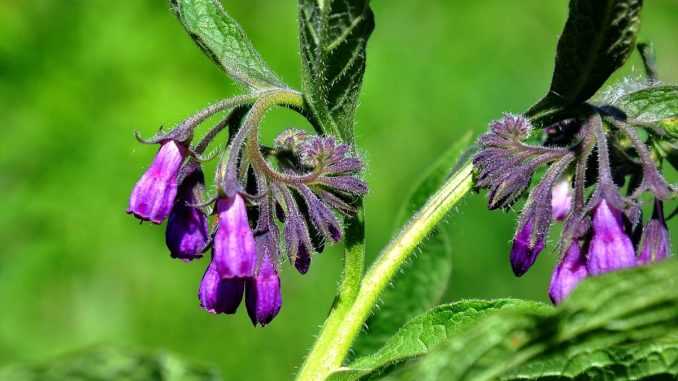
Cultivating comfrey can be a rewarding experience, whether you’re interested in its medicinal properties or its ability to improve soil fertility. By following the tips outlined in this guide, you can successfully grow and benefit from this versatile plant.
Benefits and Properties of Comfrey
- Comfrey has been used for centuries in traditional medicine for its various beneficial properties.
- It is known for its anti-inflammatory effects, making it a popular remedy for treating bruises, sprains, and other musculoskeletal injuries.
- The plant contains allantoin, which promotes cell growth and regeneration, making it useful for wound healing.
- Comfrey also has analgesic properties, providing pain relief when applied topically to painful areas.
- It has been used to treat various skin conditions such as eczema, psoriasis, and dry skin due to its moisturizing and soothing effects.
- Comfrey leaves can be infused to make a tea that can be consumed for its benefits, including its potential to aid digestion and relieve gastrointestinal discomfort.
- The plant is rich in vitamins and minerals, including vitamin C, vitamin A, calcium, and potassium.
- Comfrey is also known for its high content of mucilage, a gel-like substance that can help soothe and protect irritated tissues.
It is important to note that while comfrey has many potential benefits, it should be used with caution. The plant contains pyrrolizidine alkaloids, which can be toxic to the liver when consumed in large amounts or over a prolonged period. For this reason, comfrey supplements and extracts are not recommended for internal use, and it is best to consult with a healthcare professional before using comfrey for any medicinal purposes.
Comfrey as a Medicinal Herb
Comfrey (Symphytum) has been used as a medicinal herb for centuries. It is known for its healing properties and has been used to treat various ailments and injuries.
Traditional Uses
- Comfrey has traditionally been used to treat wounds, bruises, and sprains. It is believed to have anti-inflammatory properties that can reduce swelling and promote faster healing.
- The herb has also been used to alleviate pain associated with muscle and joint conditions, such as arthritis and rheumatism.
- Comfrey has been utilized for its demulcent properties, making it a popular ingredient in herbal remedies for digestive disorders, such as stomach ulcers and irritable bowel syndrome (IBS).
Active Compounds
Comfrey contains several active compounds that contribute to its medicinal properties. These include:
- Allantoin: Allantoin is a compound that is believed to stimulate cell proliferation and promote the growth of new tissue. This makes it useful in treating wounds and promoting faster healing.
- Phenolic acids: Comfrey contains phenolic acids, such as rosmarinic acid, which have antioxidant and anti-inflammatory properties. These compounds can help reduce inflammation and protect against free radicals.
- Tannins: Tannins found in comfrey have astringent properties, which can help stop bleeding and reduce inflammation.
Safety and Precautions
While comfrey has many medicinal uses, it should be used with caution due to its potential toxicity. Comfrey contains pyrrolizidine alkaloids (PAs), which can be harmful to the liver when used in excessive amounts or over a long period.
It is advised to avoid internal consumption of comfrey products unless they have been thoroughly processed to remove PAs. However, external applications, such as creams and ointments, are considered safe for short-term use.
As with any herbal remedy, it is recommended to consult with a healthcare professional before using comfrey for medicinal purposes, especially if you have any pre-existing conditions or are taking other medications.
Conclusion
Comfrey is a potent medicinal herb that has been used for centuries to treat various ailments. Its healing properties, along with its active compounds, make it a valuable tool in natural medicine. However, caution should be exercised due to its potential toxicity, and it is best to seek guidance from a healthcare professional before using comfrey for medicinal purposes.
Comfrey in Organic Gardening
Comfrey is a versatile and valuable plant that is commonly used in organic gardening. It offers numerous benefits to the garden and can improve the overall health and productivity of plants. Here are some ways in which comfrey can be utilized in organic gardening:
1. Nutrient Accumulator:
Comfrey has deep roots that can absorb nutrients from the soil, including nitrogen, phosphorus, and potassium. As the plant grows, it accumulates these nutrients in its leaves. When the leaves are harvested, they can be used as a nutrient-rich mulch or added to compost to enhance its nutrient content.
2. Organic Fertilizer:
The high nutrient content of comfrey leaves makes them an excellent organic fertilizer. They can be used as a liquid fertilizer by steeping the leaves in water for a few weeks and then diluting the resulting liquid to use as a foliar spray or soil drench. This natural fertilizer provides essential nutrients to plants and promotes healthy growth.
3. Pest Control:
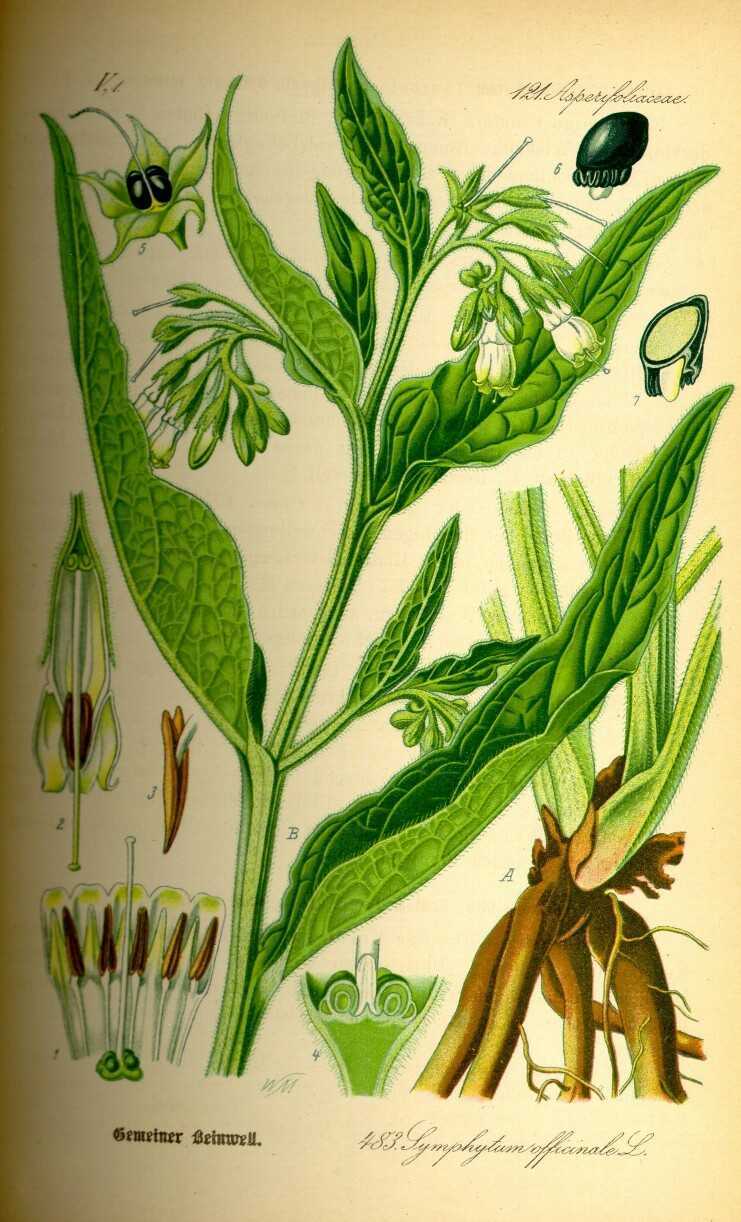
Comfrey has a strong smell that repels many pests, including aphids and slugs. Planting comfrey near susceptible plants can help deter these pests and reduce the need for chemical pesticides. Additionally, comfrey can attract beneficial insects like ladybugs and lacewings, which prey on pests and help maintain a balanced ecosystem in the garden.
4. Soil Improvement:
Comfrey’s deep roots not only absorb nutrients, but they also help break up compacted soil and improve its structure. This allows for better water drainage and root penetration. Comfrey can be grown as a cover crop or green manure, where it is cut down and tilled into the soil to improve its organic matter content and overall fertility.
5. Compost Activator:
Comfrey leaves contain high levels of an enzyme called allantoin, which speeds up the decomposition process. Adding comfrey leaves to the compost pile can help accelerate decomposition and produce nutrient-rich compost more quickly. The leaves can also be used as a compost activator when used as a layer between other organic materials.
Overall, comfrey is a valuable asset in organic gardening. It helps improve soil fertility, provides natural pest control, and serves as a potent organic fertilizer. Whether used as a mulch, liquid fertilizer, or compost activator, comfrey has numerous applications that can benefit both plants and gardeners alike.
Different Varieties of Comfrey
Comfrey is a versatile plant with various species that differ in their growth habits, leaf shapes, and flower colors. Here are some of the popular varieties of comfrey:
- Symphytum officinale: This is the most common variety of comfrey and is known for its medicinal properties. It has hairy leaves and produces flowers that are either pink or purple.
- Symphytum x uplandicum: Also known as Russian comfrey, this variety is a hybrid between S. officinale and another species. It has larger leaves and is often grown for its high nutrient content, making it a popular choice for composting and organic gardening.
- Symphytum grandiflorum: This comfrey variety is native to the Caucasus region and is characterized by its bright blue or violet flowers. It is mainly grown for ornamental purposes in gardens.
- Symphytum asperum: Native to North America, this comfrey species is often called rough comfrey due to its hairy leaves. It produces white or yellow flowers and is known for its ability to attract pollinators.
- Symphytum orientale: This comfrey variety is native to Eastern Europe and has light green leaves. It produces bright red or pink flowers and is commonly used as an ornamental plant in gardens.
Each variety of comfrey has its own unique characteristics and uses. Whether you want to grow comfrey for medicinal purposes, organic gardening, or simply for its beauty, there is a comfrey variety that suits your needs.
How to Grow Comfrey
Growing comfrey in your garden is relatively easy. Follow these steps to successfully cultivate comfrey plants:
1. Select a suitable location:
Comfrey prefers a sunny or partially shaded spot in your garden. Choose a location with well-drained soil, as waterlogged soil can cause root rot.
2. Prepare the soil:
Before planting, prepare the soil by removing any weeds or stones. Comfrey grows best in rich, fertile soil. If your soil is sandy or poor in nutrients, consider adding organic matter, such as compost or well-rotted manure.
3. Start from seeds or divisions:
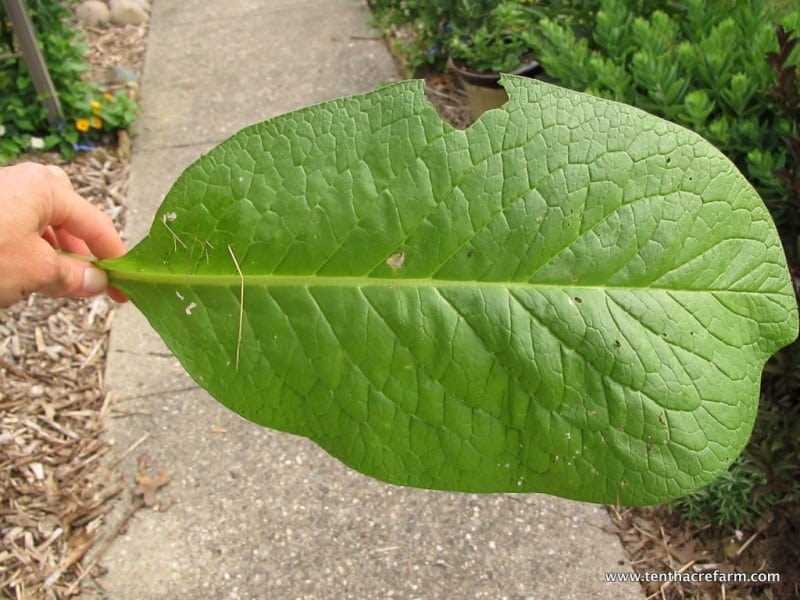
You can grow comfrey from either seeds or divisions. If starting from seeds, sow them in early spring, covering them lightly with soil. Water gently and keep the soil moist until the seedlings emerge. If using divisions, dig up an established comfrey plant, divide the root crown into smaller pieces, and replant them in the desired location.
4. Plant or transplant:
Plant comfrey seedlings or divisions around 2-3 feet apart to give them enough room to grow. Make sure to plant them at the same depth they were growing previously. Water well after planting to help the roots establish.
5. Watering:
Comfrey plants have deep taproots that can access water from lower soil levels. However, regular watering is still necessary, especially during dry periods. Aim to keep the soil consistently moist but not waterlogged.
6. Mulching:
Applying a layer of organic mulch around your comfrey plants will help retain moisture in the soil, reduce weed growth, and provide additional nutrients as it decomposes. Use materials like straw, chopped leaves, or grass clippings.
7. Fertilization:
Comfrey is known for its high nutrient content. However, to ensure optimal growth, you can feed your comfrey plants with organic fertilizers, such as compost or well-rotted manure, in the spring. This will provide them with a nutrient boost.
8. Harvesting:
Depending on how you intend to use comfrey, you can start harvesting the leaves when the plants are around 12 to 18 inches tall. Cut the leaves close to the base, leaving a few inches to allow for regrowth. Avoid overharvesting to keep the plants healthy.
9. Maintenance:
Comfrey is a low-maintenance plant that requires minimal care. Keep an eye out for pests or diseases, and promptly address any issues. Prune back the plants in late fall or early spring to promote vigorous growth.
By following these steps, you can grow comfrey plants successfully and enjoy the benefits of this versatile herb in your garden.
Harvesting and Using Comfrey
Comfrey is a versatile plant that can be harvested and used for various purposes. Whether you are growing comfrey for its medicinal properties or as a nutrient-rich mulch for your garden, knowing when and how to harvest comfrey is essential. Here are some tips on harvesting and using comfrey:
Harvesting Comfrey
- Comfrey leaves can be harvested throughout the growing season, starting from spring until early fall.
- For optimal medicinal properties, harvest the leaves when they are young and vibrant, before they start to flower.
- Wear gloves and long sleeves when harvesting comfrey, as the leaves can irritate the skin.
- To harvest, cut the leaves close to the base of the plant, leaving about 2-3 inches of the stem intact.
- Harvest only a few leaves per plant at a time, allowing the plant to continue growing.
Using Comfrey Leaves
- Comfrey leaves can be used fresh or dried for various purposes.
- To dry comfrey leaves, spread them out in a single layer in a well-ventilated area away from direct sunlight. Turn them occasionally until they are dry and crumbly.
- Dried comfrey leaves can be stored in an airtight container and used for making herbal teas or infusions.
- Comfrey leaves can be chopped and used as a nutrient-rich addition to compost piles or as a mulch around plants. They help improve soil fertility and moisture retention.
- For medicinal use, comfrey leaves can be used to make poultices, ointments, or creams to aid in healing bruises, sprains, and other skin conditions.
Using Comfrey Roots
Comfrey roots contain higher concentrations of allantoin, a compound known for its healing properties. Here are some ways to use comfrey roots:
- To harvest comfrey roots, dig up the plant in the spring or fall, when the plant is dormant.
- Wash the roots thoroughly and chop them into small pieces.
- Comfrey root extract can be used to make herbal salves or creams for treating joint pain, arthritis, or other inflammatory conditions.
- Comfrey root can also be used as a natural fertilizer. Bury the chopped roots in the soil around plants to provide a nutrient boost.
Remember to always consult with a healthcare professional before using comfrey for medicinal purposes. While comfrey has many beneficial properties, it should be used with caution due to its potential liver toxicity.
Comfrey in Permaculture: A Sustainable Solution
Permaculture is an ecological design approach that aims to create sustainable and self-sufficient systems by observing and imitating natural ecosystems. Comfrey, a multipurpose plant with numerous beneficial properties, is widely used in permaculture practices due to its ability to enhance soil fertility and provide medicinal benefits.
Soil Improvement
Comfrey has deep-reaching roots that extract nutrients from the soil and accumulate them in its leaves. These accumulations can then be harvested and used as a potent organic fertilizer. The high levels of nitrogen, potassium, and phosphorus found in comfrey leaves make it an excellent addition to compost piles or as a direct mulch around plants.
Furthermore, comfrey’s extensive root system helps break up compacted soil, improve aeration, and enhance water infiltration. Its deep roots also provide a pathway for other plants to access nutrients and water from lower soil layers.
Natural Pest Control
The strong smell and hairy leaves of comfrey act as a deterrent to some pests, making it an excellent companion plant in permaculture gardens. Planting comfrey near susceptible crops can help reduce pest damage and decrease the need for chemical pesticides.
Additionally, comfrey produces allantoin, a compound known for its healing properties. When comfrey leaves decompose, they release allantoin into the soil, which can repel nematodes and other harmful soil organisms.
Medicinal Uses
Comfrey has been used for centuries in traditional medicine to treat a variety of ailments. Its anti-inflammatory properties make it effective in relieving pain, healing wounds, and reducing swelling. Comfrey leaves can be used to make poultices, oils, or teas for external or internal use.
However, it’s important to note that comfrey contains alkaloids, which can be harmful if ingested in large quantities or over extended periods. Therefore, it is recommended to consult with a healthcare professional before using comfrey for medicinal purposes.
Conclusion
Comfrey is a valuable plant in permaculture systems, offering benefits such as improved soil fertility, natural pest control, and medicinal uses. Its deep roots and nutrient-rich leaves make it an ideal choice for enriching the soil, while its natural repellent properties help protect crops from pests. Additionally, comfrey’s healing properties make it a valuable plant for traditional medicine. By integrating comfrey into permaculture designs, gardeners can create more sustainable and resilient ecosystems.
Questions and Answers:
What is comfrey?
Comfrey is a perennial herb that belongs to the Boraginaceae family. It is known for its medicinal properties and is often used in traditional herbal medicine.
How can I cultivate comfrey in my garden?
Cultivating comfrey in your garden is relatively easy. You can either grow it from seeds or plant root cuttings. Comfrey prefers moist, well-drained soil and partial shade. It is a hardy plant that can tolerate a wide range of conditions.
What are the properties of comfrey?
Comfrey has several medicinal properties. It is known for its anti-inflammatory and analgesic effects, making it useful for treating sprains, bruises, and joint pain. It also contains compounds that promote cell growth and can aid in wound healing.
Are there different species of comfrey?
Yes, there are several species of comfrey, including Symphytum officinale, Symphytum x uplandicum, and Symphytum grandiflorum. Each species has its own unique characteristics and medicinal properties.
Can I use comfrey as a natural fertilizer?
Yes, comfrey can be used as a natural fertilizer. Its leaves are rich in nutrients, including potassium, phosphorus, and nitrogen. To make comfrey fertilizer, you can chop up the leaves and steep them in water for a few weeks.
What precautions should I take when using comfrey?
While comfrey has many beneficial properties, it should be used with caution. The plant contains pyrrolizidine alkaloids, which can be toxic to the liver when ingested in large quantities. It is best to avoid consuming comfrey internally and to use it externally in moderation.







